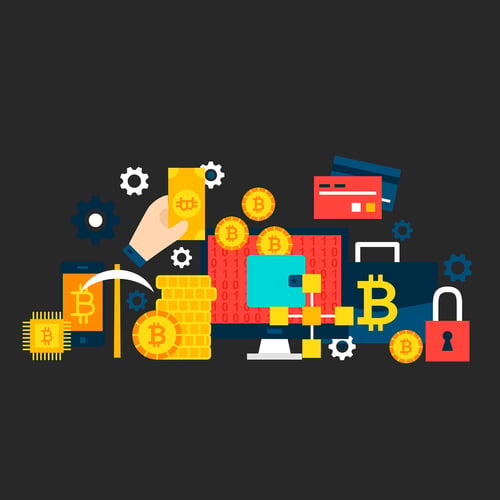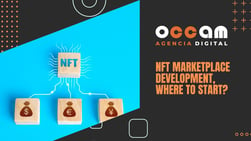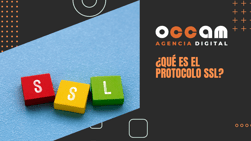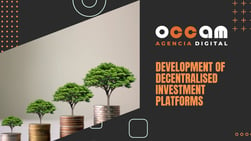Index Content
do you know how to use blockchain technology? Find out how a blockchain development company can help you.
Blockchain is one of those concepts that on its own makes no sense, but when applied to a sector or community, it revolutionises everything. In fact, the financial sector has never been the same since the appearance of cryptocurrencies in 2009, at least in terms of security and transparency. And probably, the automotive, health, legal, food and investment industries, among many others, won't be either after learning how blockchain works, its most common uses and the advantages it brings.
Today we want to share with you everything you should know about one of the most revolutionary technologies of the moment and why to look for a blockchain development company. It won't take you more than 5 minutes to learn something that can change the course of your business forever.
will you join us?
what is blockchain?
It literally means blockchain. It is a public database or registry that can be shared by a multitude of users in peer-to-peer (P2P) mode and that allows information to be stored in an immutable and organised way.
It is a term associated with cryptocurrencies because, apart from being the technology that underpins them, it was born with the first virtual currency in history in 2009, Bitcoin. In this case, the data added to the blockchain is public and can be consulted at any time by network users.
However, it is important to remember that cryptocurrencies are just that, currencies! Just like the euro, the dollar or any type of paper currency. Each one is a simple material with a printed value, but what enables their use and generates value are the economic laws that support them.
Something similar happens with virtual currencies. In this case, it is blockchain technology that enables their operation. Its main objective is to create an unmodifiable record of everything that happens in the blockchain, so we are talking about a secure and transparent system.
Bitcoin (BTC), Ethereum (ETH) or any other cryptocurrency is simply a virtual currency built on the blockchain and used to send or receive the amount of money that each participant owns. This technology is the one that keeps public record of transactions, but keeping the identity of the participants anonymous.
However, although it was created to store the transaction history of Bitcoin, over the years it has been identified as having great potential for application in other areas and sectors due to the possibilities it offers.
"The blockchain is the technology, cryptocurrencies are simply the first manifestation of its potential " - Marc Kenigsberg
Characteristics of blockchain technology
The progress of this system has been unknown since its inception, but little by little we are learning more details of how it works:
- Security
Cryptography is a fundamental pillar in the functioning of the blockchain, which provides security for the data stored in the system, as well as for the information shared between the nodes of the network. When we are going to carry out a transaction, we need a set of valid asymmetric keys to be able to carry it out on the blockchain. It is also known as public key cryptography.
- Trust
By representing a shared record of events, this technology builds trust among users. Not only that, it eliminates the possibility of manipulation by hackers and creates a ledger of transactions that can be accessed by all members of the network.
- Immutability
Once information is added to the distributed database, it is virtually impossible to modify it. Thanks to asymmetric cryptography and hash functions, a distributed ledger can be implemented to ensure security, and consensus on data integrity can be reached among network participants without having to rely on an entity to centralise the information.
- Transparency
In blockchain, transparency is achieved by making public the software code to execute the chain, as well as generating a community of nodes that apply it. Its application in different activities, such as supply chains, allows the traceability of the product from the origin.
- Traceability
It allows the knowledge of all the operations carried out, as well as the review of the transactions made at a specific moment. Traceability is a procedure that allows following the evolution of a product in each of its stages, as well as who, how, when and where it has been intervened on. This is one of the main reasons why many sectors are beginning to apply blockchain technology.
3 keys to understanding how the blockchain works
You are just one step away from knowing everything about the blockchain. Now that you know its definition and the main characteristics and related terms, it is time to put everything you have learnt together to discover how it works. Take note!
- The jack, horse, king of transactions
Networks use peer-to-peer data exchange technology to connect different users who share information. In other words, the data is not centralised in a central system, but shared by all the users of the network. When a transaction is made, it is recorded as a block of data transmitted to all parties in order to be validated.
The transaction is the movement of an asset and the block can record the information of your choice, from what, who, when, where, how much and how. Each block is connected to the previous and subsequent ones forming a chain (blockchain), as a kind of indelible record. Each additional block reinforces the verification of the previous one and eliminates the possibility of being manipulated. Finally, the transaction is carried out.
- The structure of the blocks
The chain stores a lot of information, which allows it to grow over time, which is why it has been necessary to create efficient query mechanisms without the need to download all the information: the Merkle hash tree.
This is a data tree structure that allows a large number of separate pieces of data to be related to a single hash value, providing a very efficient method of verifying the contents of large information structures.
- Blockchain block generation
First of all, it is a decentralised process. This requires a distributed consensus in which nodes have the ability to generate valid data. Users must become nodes within the system in order to issue new transactions. If they wish to become miners and create blocks, then they must compete with others. The validation process is based on asymmetric cryptography, with one public and one private key. The transactions issued are validated by the nodes in the new mined block, as well as their correct linkage to the previous block (it must contain the hash).
The most common uses of the blockchain
"But this technology was created for cryptocurrency trading".
That's right, but the passage of time, research and social needs have seen great potential in this technology to be applied in other areas:
- Voting systems
Some states such as West Virginia are implementing electronic voting through the blockchain, although it is still a framework to be regulated. However, it is not necessary to go that far. After the last elections to the Madrid Assembly, as well as the pandemic situation of COVID-19 and its restrictions on mobility and the gathering of people, they have raised the establishment of electronic voting with blockchain. Its traceability and immutability make it a very attractive system for voting. Not only would it increase transparency and reliability, but it could also audit in real time.
- Smart Contracts
These are programmes that allow the fulfilment and execution of registered agreements between the parties automatically. They can be applied in any type of transaction where a registered agreement is necessary, such as a guarantee deposit or the contracting of a product, among others. Among their main characteristics are: self-execution and immutability. Find out about some examples of smart contracts in Spain at this link.
- Supply chain
Monitoring and tracking in food chains, as well as in production is one of the main applications raised with blockchain. Some examples of this technology in the food and agricultural industry are: Walmart China, with food production constituted by IBM; or the Australian AgriDigital, which works with distributed ledgers, blockchain and Smart Contracts.
At Occam Agencia Digital, as a blockchain development company, we are convinced that it is not just about programming, but about analysing the client's needs and designing a unique user experience.
how can you take advantage of the benefits of blockchain in your business? Tell us your doubts, we can help you solve them.
- Tokenisation of real estate and assets
thanks to the transparency of the blockchain, asset tokenisation is revolutionising traditional sectors such as real estate investment by democratising the purchase of real estate.
This breaks down the barrier of investing in more secure assets, since, until now, if you wanted to buy a property, you had to do it alone or among a very small group of people. Thanks to tokenisation, you can now buy a flat among 100, 200, 1000 people by making a small contribution.
This also allows you to diversify and minimise risk, being able to invest €100 in several properties.
It is very important to choose a blockchain development company that has developed a project using this technology, as these are complex developments with very little documentation on the internet to help developers.
how to make a good blockchain development?
We invite you to take note of the necessary steps for blockchain development:
- The first thing to do is a briefing between both parties. The client provides the information of the business model, and the blockchain development company offers the expertise to design the platform using the most optimal technology.
It is very important to choose the right technologies to be used, since in blockchain each transaction has a cost. Depending on the blockchain chosen, each transaction can cost between €10 or €0.0001.
It is also important for the blockchain development company to design which parts of the platform should work in order to have a balanced system of security, user experience and cost per use that is appropriate and adapted to the business model proposed by the client.
For example, if you want to develop a platform to tokenise real estate so that investors can buy real estate tokens, it is recommended that all the functionality related to the purchase or investment is developed on blockchain technology, and the rest of the functionalities are developed in the traditional way. In this way, you will achieve a good user experience, high security in purchases and low costs. - Once the briefing is finished, we move on to the design phase. With the briefing in hand, it is time for the UX and UI experts to get down to work. With the information gathered, you must design a platform with a great user experience and a friendly interface to transmit confidence to the user and allow them to operate in a very simple way. In this way, you will avoid frustration and abandonment on the platform.
Occam is a blockchain development company that has a design department, as it is not only important the technological part. It does not help us if the technical part of the project is resolved if we do not make the client's platform usable for users. - When the platform is designed, the development team begins to programme all the functionalities defined in the briefing and to lay out the platform as defined in the design.
This is the phase that takes the longest, as at this point we are converting the idea into something real. Here we move from plans to reality, to create the platform that users will use.
Moreover, in a blockchain development we have to take into account all the components of a traditional development (Database, Backend, API, FrontEnd...) added to the blockchain components (SmartContracts, Gas, the blockchain itself to use ....), so it is a job in which we have to have high precision. - Now that we have the platform, we are going to test it, to test it among several people: the developers, the client, the blockchain development company, etc. The more participants there are, the better. We will discover small bugs and probably some shortcomings not found in the design and that, at the time of use, we need to solve. For example, a manual on how to invest, what steps to take within the platform, a pop-up that warns us of any extra configuration, etc.
- Once testing is finished, we move on to deployment. We select the optimal server for the operation of the platform in order to adapt it to the resources that the client may consume. Now, we move from working on the test blockchain to the mainnet. That is, the real environment.
It is not necessary to remember these steps from start to finish, at Occam we accompany you throughout the process and you can consult your doubts at any time.
what types of test blockchains are there?
There are a large number of blockchains, and with them, test blockchains.
For example, Bitcoin's proof blockchain is called Tesnet, but there are others like Ethereum's that have several proof blockchains such as Robsten, Kovan, Rinkeby, Goerli.
All of them work in the same way, so we can use the one we want. In this case, as the most important functionality provided by this technology, from a development point of view, is Smart Contracts, we are going to focus on Ethereum and talk about Robsten.
When we are developing Smart Contracts, it is going to be necessary to carry out thousands of tests to check that everything is as planned. We cannot use a real blockchain, as the cost would skyrocket and it would not make any sense, as the test blockchains are going to provide us with the same thing.
If we select the Robsten network as a test blockchain, we can obtain free ETH (obviously, this ETH is not the real one) to carry out the tests. When we spend it, we can continue to order more at this link https://faucet.ropsten.be/ by entering the public address of our wallet.
On the other hand, to see the transactions, you can do it in https://ropsten.etherscan.io/
which public blockchains are commonly used to develop platforms?
A blockchain development company should be able to use public blockchains:
- Ethereum
- Binance Smart Chain
- xDAI
Each of these has its advantages and disadvantages, the most important of which are listed below:
|
Ethereum |
Binance Smart Chain |
xDAI |
|
|
Transaction costs |
High |
Medium |
Low |
|
Transaction speed |
High |
High |
High |
|
Compatibility with other platforms |
Very high |
Low |
Low |
|
Liquidity |
High |
High |
Medium |
Ethereum is the most widely used network in the world for Smart Contracts, so it is implemented in many platforms. If we develop ours on Ethereum, we will be able to be synchronised with all of them. For example, if we develop an ERC20 token exchange on Ethereum, users will be able to send them to Binance, Kraken or their metamask without having to do any extra development, since these platforms also use the Ethereum network.
The big drawback that this blockchain currently has is the cost per transaction, although, when ETH 2.0 arrives, this will be solved.
On the other hand, the Binance Smart Chain solves the cost of gas, i.e. the cost per transaction, making it considerably cheaper. However, it is a highly centralised network created by a private company, and at the moment it does not have a large ecosystem outside Binance compared to Ethereum, despite being under construction.
If we talk about xDAI, it is a blockchain with ridiculous transaction costs and with a very powerful feature: its currency is a stablecoin, which means that its value is fixed, in this case 1 xDAI = 1 US dollar.
do you need to make a decision? Choosing between one blockchain or another is key, and the blockchain development company should do so when designing the briefing, at which point it should know which one is the most suitable for the client's business model.






